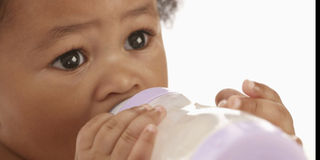Guidelines on bottle feeding

Feeding teats wear out fast as a result of frequent friction. Some babies chew on the teat. Replacing teats regularly ensures that they are safe to use. PHOTO/FILE
What you need to know:
- At some point, every mother needs to buy feeding equipment for her baby.
- Before putting anything in the feeding bottle, always ensure that the teats and bottle are clean and dry.
- Feeding teats wear out fast as a result of frequent friction. Some babies chew on the teat.
When bottle-feeding your baby with expressed breast milk or formula, there are certain precautions you need to take to ensure that your baby is safe.
- Buying a feeding bottle:
At some point, every mother needs to buy feeding equipment for her baby.
Whether it is for feeding her baby with expressed breast milk, water, infant formula, or juices later during weaning, using a bottle is often inevitable.
Feeding bottles are usually made of food-grade plastic.
However, the shape or design of the bottle might make it difficult to clean, so choose a bottle that is easy to clean.
- Sterilisation and safety:
Before putting anything in the feeding bottle, always ensure that the teats and bottle are clean and dry.
They should be hygienically stored to ensure that they are safe to use.
Exposing them to dirt might make them infect the child, which could lead to serious health problems.
When using infant formula, read the label on preparation before making the feed.
Be Prepared:
Before you begin feeding the baby, get everything set and and make sure you are comfortably seated.
You might need to allow your baby some time in between the feeding. Some babies take a little milk and pause for a nap.
You should be prepared to stay with the baby until he/she is satisfied.
Feeding the baby offers an opportunity for the mother to bond with her baby.
- Keep the teat full:
When bottle feeding, ensure the teat is always full since leaving it empty causes the baby to take in air.
If the teat becomes flattened during feeding, pull it gently at the corner of the baby’s mouth to release air.
If it happens to be blocked, replace it with a sterile one.
- How to hold the baby:
Always hold the baby in a near-upright position when feeding him or her and support his or her head to allow easy breathing and swallowing.
- Dispose of unused formula:
Always throw away unfinished breast milk or formula since giving it to the baby might cause food poisoning.
In addition, feed the baby only when he or she is hungry.
Do not force him or her to finish a bottle.
- Always be around:
Never leave the baby to feed on their own from a propped up bottle. It can cause the baby to choke.
- Replace teats regularly:
Feeding teats wear out fast as a result of frequent friction. Some babies chew on the teat.
When defragmented, the teat can harbour dirt and be difficult to clean.
Replacing teats regularly ensures that they are safe to use.




